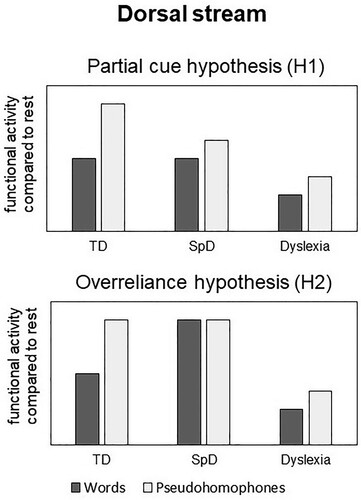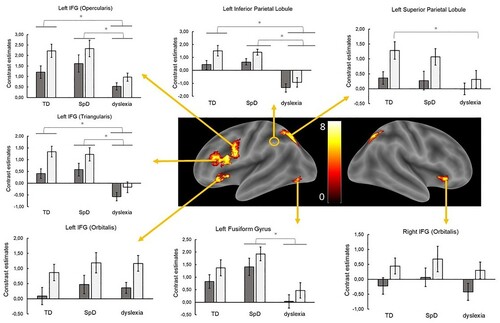Figures & data
Figure 1. Competing hypotheses of expected functional activity in the dorsal stream in the two deficit groups compared to typically developing children.

Table 1. Mean scores (M) and standard deviations (SD) for descriptive, literacy, and cognitive measures in the three groups.
Figure 2. Example of the in-scanner task. Children were instructed to read aloud German words (as for example “Familie” [family]) and pseudohomophones (as for example “Fater”, which sounds as the German word “Vater” [father]).
![Figure 2. Example of the in-scanner task. Children were instructed to read aloud German words (as for example “Familie” [family]) and pseudohomophones (as for example “Fater”, which sounds as the German word “Vater” [father]).](/cms/asset/f04756ab-a0d1-476a-8535-69e8cbe58fc6/plcp_a_1859569_f0002_ob.jpg)
Table 2. Accuracy in the in-scanner reading aloud task for the three groups, presented separately for each condition.
Table 3. Results of group comparisons for the condition “words” displayed with FWE correction at the voxel level, p < .05. Clusters ≥ 10 voxels are reported.
Table 4. Results of group comparisons for the condition “pseudohomophones” displayed with FWE correction at the voxel level, p < .05. Clusters ≥ 10 voxels are reported.
Table 5. Brain activity for the contrast words vs. pseudohomophones in the whole sample. Clusters are displayed with FWE correction at the voxel level, p < .05. Clusters ≥ 10 voxels are reported.
Figure 3. Group-related activity for words vs. pseudohomophones in each selected ROI based on the results of the whole-brain analysis, FWE-corrected at the voxel level, p < .05. Dark-grey boxes indicate functional activity for words, light-grey boxes for pseudohomophones. Bars represent standard errors.

